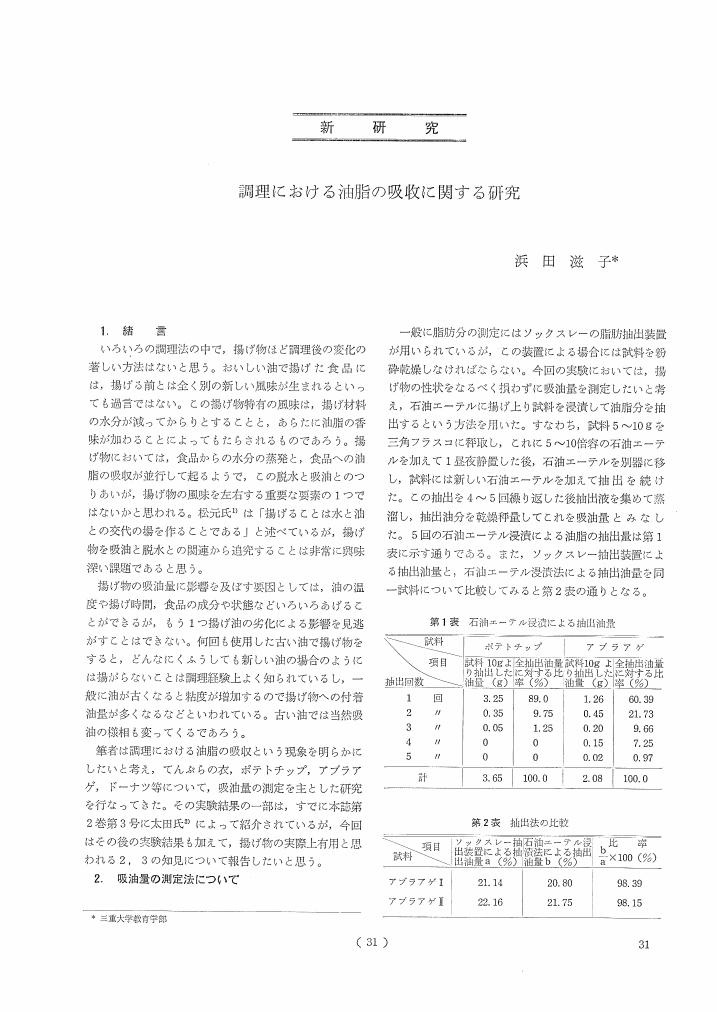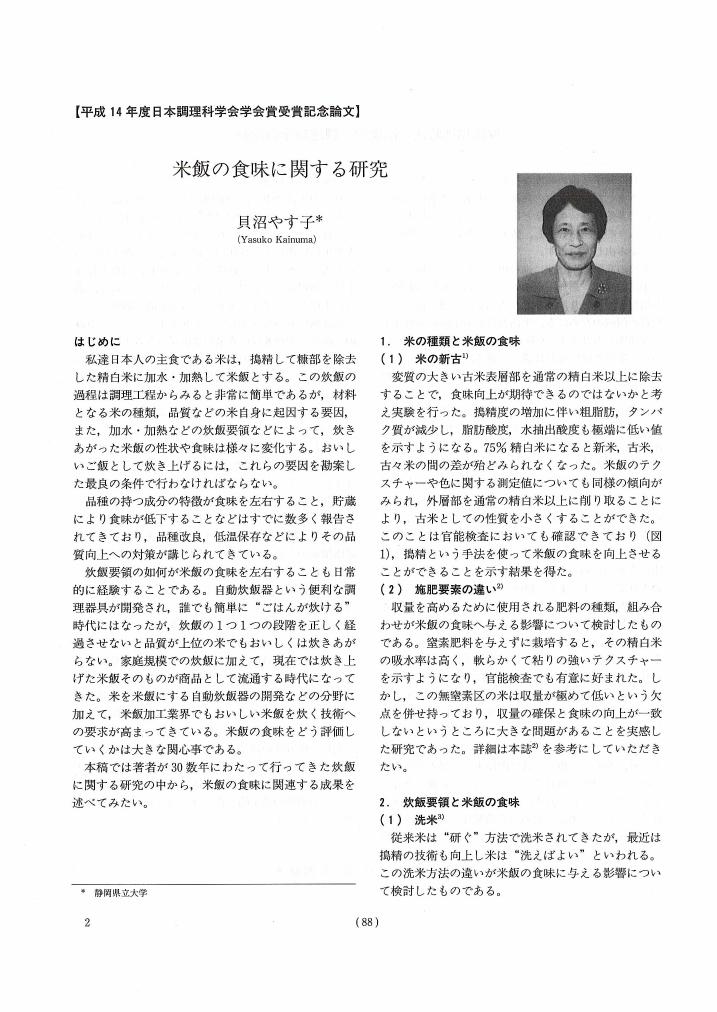2 0 0 0 OA おいしさを評価する用語
- 著者
- 早川 文代
- 出版者
- 一般社団法人 日本調理科学会
- 雑誌
- 日本調理科学会誌 (ISSN:13411535)
- 巻号頁・発行日
- vol.41, no.2, pp.148-153, 2008-04-20 (Released:2013-04-26)
- 参考文献数
- 35
- 被引用文献数
- 1
2 0 0 0 OA フランス社会の変遷と料理への影響
- 著者
- 宇田川 政喜
- 出版者
- 一般社団法人 日本調理科学会
- 雑誌
- 調理科学 (ISSN:09105360)
- 巻号頁・発行日
- vol.27, no.2, pp.147-152, 1994-05-20 (Released:2013-04-26)
2 0 0 0 OA 固形物の硬さがきざみ食の食べやすさに及ぼす影響
- 著者
- 岩崎 裕子 大越 ひろ
- 出版者
- 一般社団法人 日本調理科学会
- 雑誌
- 日本調理科学会誌 (ISSN:13411535)
- 巻号頁・発行日
- vol.46, no.1, pp.23-30, 2013 (Released:2013-11-22)
- 参考文献数
- 23
- 被引用文献数
- 2
大根とゾルを混合した混合系試料を調整し,固形物の硬さの相違が混合系試料の食べやすさへ及ぼす影響を検討するため,力学的特性の測定,官能評価,筋活動測定を行った。 混合系試料は大根とトロミ調整食品を混合して調製した。大根は,加圧加熱,蒸し加熱,生,と硬さを段階的に変化させた三試料を用い,それぞれMR,MS,MPとした。コントロールとして蒸し大根のみの試料を大根Sとした。 喫食者にとっては試料全体ではなく,固形物の硬さが重要であることが示された。また,大根Sが混合Rよりも総筋活動量が低く,官能評価において飲み込みやすいと評価され,ゾルと混合することよりも,食品の硬さをある程度軟らかくすることが,きざみ食の食べやすさの改善に有効であることを示した。
2 0 0 0 OA 調理における油脂の吸收に関する研究
- 著者
- 浜田 滋子
- 出版者
- 一般社団法人 日本調理科学会
- 雑誌
- 調理科学 (ISSN:09105360)
- 巻号頁・発行日
- vol.3, no.1, pp.31-37, 1970-02-20 (Released:2013-04-26)
- 参考文献数
- 24
- 被引用文献数
- 4
2 0 0 0 OA 加熱時における動物性食品中のヘム色素の分解
- 著者
- 山本 由喜子 松村 多紀子
- 出版者
- 一般社団法人 日本調理科学会
- 雑誌
- 調理科学 (ISSN:09105360)
- 巻号頁・発行日
- vol.26, no.2, pp.106-109, 1993-05-20 (Released:2013-04-26)
- 参考文献数
- 9
Total iron and non-heme iron contents of meats and fishes were determined. A colorimetric non-heme iron assay method modified by Rhee and Ziprin was used to determine the non-heme iron content. Non-heme iron, expressed as percent of the total iron in raw beef inside round, pork inside ham, chicken thigh, and chicken breast was 20,48,44, and 39%, respectively. The percentage of non-heme iron in sardine (all of edible portion), sardine (dark meat), sardine (white meat), pacific saury, flatfish, and bastard halibut was about 42,51,20,66,40, and 58%, respectively. The effect of roasting on nonheme iron contents in these foods was also studied. Roasting meats at 100°C did not increase the nonheme iron contents of the meats. Heating at 170°Creleased a significant amount of non-heme iron from bound heme pigments in meats exceptp pork inside ham. Roasting fishes at 100°C released a significant amount of non-heme iron from heme pigments, and the non-heme iron contents in fishes increased as the temperature rose and the period of the heat treatment increased. The destruction of heme pigment in meats and fishes was observed when the internal temperature of these foods was above 60°C, except pork inside ham.
2 0 0 0 OA 米飯の食味に関わる米内在性酵素の局在と炊飯中の挙動
- 著者
- 露久保 美夏
- 出版者
- 一般社団法人 日本調理科学会
- 雑誌
- 日本調理科学会誌 (ISSN:13411535)
- 巻号頁・発行日
- vol.46, no.3, pp.145-152, 2013 (Released:2013-08-20)
- 参考文献数
- 51
2 0 0 0 OA 市販生和菓子の微生物汚染と糖分含有量について
- 著者
- 会田 久仁子 角野 幸子 小林 智子 角野 猛
- 出版者
- 一般社団法人 日本調理科学会
- 雑誌
- 調理科学 (ISSN:09105360)
- 巻号頁・発行日
- vol.22, no.1, pp.74-77, 1989-03-20 (Released:2013-04-26)
- 参考文献数
- 13
In order to clarify the bacterial contamination and sugar contents of wet Japanese-style confectioneries on the market, we examined 84 samples by inspecting total bacterial counts, coliform group, sucrose, glucose and fructose contents.The results obtained were as follows:1. The total bacterial counts were in the range of below 3.0×102/g to 9.1×106/g.2. Detection percentage of coliform group in Mushimono, Mochimono, Yakimono and Nerimono were 5.4%,40.9%,5.9% and 0%, respectively.3. Mean contents of sucrose of Mushimono, Mochimono, Yakimono and Nerimono were 299.8mg/g,289.1mg/g,311.2mg/g and 399.4mg/g, respectively.4. Mean contents of glucose and fructose of wet Japanese-style confectioneries were 7.3mg/g and 4.5 mg/g, respectively.
2 0 0 0 OA 視覚によるおいしさと後光効果~給食用トレイの色に焦点を当てて
- 著者
- 冨田 圭子
- 出版者
- 一般社団法人 日本調理科学会
- 雑誌
- 日本調理科学会誌 (ISSN:13411535)
- 巻号頁・発行日
- vol.48, no.2, pp.166-168, 2015 (Released:2015-05-02)
- 参考文献数
- 11
2 0 0 0 OA 富山の魚介類の特徴と地域性
- 著者
- 原田 澄子 大菅 洋子 塩原 紘栄 深井 康子 守田 律子 吉田 紀子
- 出版者
- 一般社団法人 日本調理科学会
- 雑誌
- 日本調理科学会誌 (ISSN:13411535)
- 巻号頁・発行日
- vol.39, no.2, pp.180-183, 2006-04-20 (Released:2013-04-26)
- 参考文献数
- 3
2 0 0 0 OA 茶碗蒸しの物性に及ぼす影響因子の解析
- 著者
- 久塚 智明 小川 宣子 渡邊 乾二
- 出版者
- 一般社団法人 日本調理科学会
- 雑誌
- 日本調理科学会誌 (ISSN:13411535)
- 巻号頁・発行日
- vol.32, no.4, pp.312-316, 1999-11-20 (Released:2013-04-26)
- 参考文献数
- 6
Samples of savory cup custard obtained from the food service industry were analyzed for the concentration of egg solution by the amount of protein, for the ratio of egg yolk solution by the total amount of phophorous, and for the quantity of dried bonito by the amount of histidine.The concentration of egg solution in the samples of savory cup custard prepared by the food service industry varied from 21.9% to 33.2%. The ratio of egg yolk to egg solution and the bonito concentration in the samples from special shops were larger than in those from general shops.The sensory evaluation result showed that the savory cup custard with an egg solution concentration of 25%, a breaking strength of 3734±267 Pa and a storage modulus of 135±18 Pa was most favored by the panelists.The ratio of egg yolk to egg solution corresponded to the breaking strength. It is clear that both the 30∼40% and 65∼80% ratio of egg yolk to whole egg contributed to the firmness of a good savory cup custard. It is suggested that the addition of egg yolk to whole egg is the best method for preparing savory cup custard. The samples prepared at the ratio of 65∼80% egg yolk to whole egg did not have a smooth texture and strong egg yolk flavor which is not a desirable feature in a good-quality savory cup custard.
2 0 0 0 同じ条件で栽培した高糖度トマトと大玉トマトの比較
- 著者
- 綾部 園子 本間 千裕 長浜 ゆり 高橋 伸幸
- 出版者
- 一般社団法人 日本調理科学会
- 雑誌
- 日本調理科学会誌 = Journal of cookery science of Japan (ISSN:13411535)
- 巻号頁・発行日
- vol.42, no.3, pp.188-193, 2009-06-20
- 参考文献数
- 17
同じ条件で栽培したF<sub>1</sub>種のフルーツトマト(甘しずく)と普通のトマト(麗容),および比較のため特殊栽培によるフルーツトマト(アメーラ)の品質と嗜好性について検討した。その結果,甘しずくの糖度は,麗容と同じ栽培方法であったが,アメーラとほぼ同じであった。甘しずくとアメーラは麗容に比べてフルクトースとグルコースの含量が多かった。フルクトース/グルコースは甘しずくはアメーラよりも高く,甘味の質が異なることが示唆された。酸度は甘しずくのゼリー部において有意に高かったが,果肉においては有意の差はなかった。皮付きの破断応力は甘しずくが最も高く,皮を除いた果肉の圧縮応力はアメーラが最も高かった。官能評価の結果,麗容に対し甘しずくとアメーラは有意に好まれた。
2 0 0 0 OA 加熱における醤油調味液の香気成分の変化
- 著者
- 孟 琦 今村 美穂 小幡 明雄 菅原 悦子
- 出版者
- 一般社団法人 日本調理科学会
- 雑誌
- 日本調理科学会誌 (ISSN:13411535)
- 巻号頁・発行日
- vol.48, no.4, pp.249-254, 2015 (Released:2015-09-05)
- 参考文献数
- 18
- 被引用文献数
- 2
醤油にみりんと砂糖を添加した調味液の加熱による香気の質的変化とその寄与成分を解明するために,醤油とその調味液から香気濃縮物を調製し,香気濃縮物を比較した。香気濃縮物のGC-O分析の結果,調理加熱によって感知できる香気成分数は醤油では減少したが,調味液では増加した。AEDA分析の結果,調理加熱前後の調味液中のFDfが最も高かったのはカラメル様のHEMFで寄与度に変化はなかったが,醤油ではHEMFの寄与度が低下した。みりんの主要成分であるグルコースを添加したモデル調味液は,調理加熱後に感知できる香気成分数が増加し,HDMFとHMFの寄与度が上昇した。このような香気成分の変化は,調味液と酷似していた。これらの結果は,グルコースを多く含むみりんの添加が調味液の調理加熱による香気の形成に大きく寄与することを示している。
2 0 0 0 OA 食肉の特性と利用
- 著者
- 千国 幸一
- 出版者
- 一般社団法人 日本調理科学会
- 雑誌
- 日本調理科学会誌 (ISSN:13411535)
- 巻号頁・発行日
- vol.40, no.1, pp.33-36, 2007-02-20 (Released:2013-04-26)
- 参考文献数
- 9
2 0 0 0 OA 魚の加熱調理における本みりんの脂質酸化抑制効果
- 著者
- 石田 丈博 福井 裕 松田 秀喜 的場 輝佳
- 出版者
- 一般社団法人 日本調理科学会
- 雑誌
- 日本調理科学会誌 (ISSN:13411535)
- 巻号頁・発行日
- vol.38, no.6, pp.480-485, 2005-12-20 (Released:2013-04-26)
- 参考文献数
- 20
- 被引用文献数
- 5
Takehiro Ishida Hiroshi Fukui Hideki Matsuda Teruyoshi Matoba The anti-oxidative effect of mirin on whole sardines and sardine fish-balls was investigated during thermalcooking. The thiobarbituric acid (TBA) values of both after cooking with mirin were lower than those cookedwith mirin-like seasoning or sugar.The TBA values after cooking with mirin or ethanol- eliminated mirin were also lower than those cooked withethanol or water.The 1, 1-diphenyl-2-picrylhydrazyl (DPPH) radical-scavenging activity of the whole sardine, its broth and itsfish-ball after thermal cooking with mirin were all higher than those cooked with mirin-like seasoning or sugar.
2 0 0 0 OA 油脂の過酸化反応理論
- 著者
- 寺尾 純二
- 出版者
- 一般社団法人 日本調理科学会
- 雑誌
- 日本調理科学会誌 (ISSN:13411535)
- 巻号頁・発行日
- vol.28, no.3, pp.190-195, 1995-08-20 (Released:2013-04-26)
- 参考文献数
- 17
2 0 0 0 OA 米飯の食味に関する研究
- 著者
- 貝沼 やす子
- 出版者
- 一般社団法人 日本調理科学会
- 雑誌
- 日本調理科学会誌 (ISSN:13411535)
- 巻号頁・発行日
- vol.36, no.2, pp.88-94, 2003-05-20 (Released:2013-04-26)
- 参考文献数
- 37
- 被引用文献数
- 1
2 0 0 0 OA 紅茶水色に対する金属塩類および水の硬度の影響
- 著者
- 下橋 淳子 寺田 和子
- 出版者
- 一般社団法人 日本調理科学会
- 雑誌
- 調理科学 (ISSN:09105360)
- 巻号頁・発行日
- vol.26, no.3, pp.225-229, 1993-08-10 (Released:2013-04-26)
- 参考文献数
- 5
The effects of metallic salts and the hardness of water on the color of black tea infusion were examined.Water with the hardness of 70°-80° of calcium and the concentration of about 30 ppm of calcium ion produced the strongest redness. The addition of calcium ionmore than 60 ppm to the water caused the cream down.Water with the hardness of magnesium more than 400°and the concentration of magnesium ion more than 97 ppm had an effect on the color of black tea infusion.It is clarified that magnesium dose not practically affect the color of black tea infusion and from the sensory test, various factors such as the balance of redness and yellowness, value, chroma and transparency interact in the color of black tea infusion.The soft water with the hardness lower than 75° and the concentration of calcium ion less than 25ppm, is preferable for producing the beautiful color of black tea infusion.
2 0 0 0 OA 菓子(その2)
- 著者
- 宮内 昭 西浦 孝輝
- 出版者
- 一般社団法人 日本調理科学会
- 雑誌
- 調理科学 (ISSN:09105360)
- 巻号頁・発行日
- vol.17, no.3, pp.156-164, 1984-09-01 (Released:2013-04-26)
2 0 0 0 OA 粘稠な液状食品の力学的特性と嚥下
- 著者
- 高橋 智子
- 出版者
- 一般社団法人 日本調理科学会
- 雑誌
- 日本調理科学会誌 (ISSN:13411535)
- 巻号頁・発行日
- vol.35, no.3, pp.310-316, 2002-08-20 (Released:2013-04-26)
- 参考文献数
- 7
2 0 0 0 OA しなのの味
- 著者
- 高野 悦子
- 出版者
- 一般社団法人 日本調理科学会
- 雑誌
- 調理科学 (ISSN:09105360)
- 巻号頁・発行日
- vol.4, no.2, pp.101-105, 1971-06-20 (Released:2013-04-26)
山また山の連なる信濃の乏しい食糧資源を材料にして昔の人達が生活の知恵で創り出したさまざまの味覚はいずれも素朴で庶民的な物ばかりです。これら幾つかを四季に分けて取り上げてみます。









